Failure Causes Analysis of Circumferential Cracking on Gathering Pipeline in M Oil and Gas Field
Abstract
:1. Introduction
2. Failure Sample Information
3. Detection and Results Analysis
3.1. Non-Destructive Testing
3.2. Physical and Chemical Properties
3.2.1. Tensile Properties
3.2.2. Chemical Composition
3.2.3. Charpy Impact Performance
3.2.4. Metallographic Structure and Inclusion
3.3. Failure Fracture Observation
3.4. Metallographic Structure of Fracture
3.5. Fracture Microstructure and Corrosion Product Analysis
3.5.1. Failure Fracture Analysis
3.5.2. Fracture Analysis of Tensile Sample
3.5.3. XRD Analysis of Corrosion Products on Fracture Surface
4. Comprehensive Analysis
5. Conclusions and Suggestions
- (1)
- The mechanical properties of the pipeline met the relevant standards;
- (2)
- The cause of the pipeline fracture was sulfide stress corrosion cracking;
- (3)
- It is recommended to identify the source of H2S, confirm whether the transport medium was contaminated with H2S or sulfate-reducing bacteria by-products, and assess potential cracking risks in other sections of the same pipeline;
- (4)
- It is advisable to investigate stress issues and pay special attention to critical areas, such as girth welds connecting the pipes;
- (5)
- Strict control over the composition of the conveying medium is advised to prevent H2S contamination. Continuous monitoring of anti-corrosion measures should be carried out to prevent bacterial corrosion. Quality control over pipelines, especially residual stresses at welds, should be strictly enforced. Regular non-destructive testing on pipelines is recommended to mitigate and delay pipeline failures.
Author Contributions
Funding
Institutional Review Board Statement
Informed Consent Statement
Data Availability Statement
Conflicts of Interest
References
- Wu, M.; Xie, F.; Chen, X.; Wang, D.; Sun, D.-X. Research progress and thinking on corrosion failure of buried oil and gas pipelines. Pet. Storage Transp. 2022, 41, 712–722. [Google Scholar]
- Rao, B.-Y.; Wang, C.-P.; Feng, X.-Z.; Yang, X.-L.; Lv, X.-M.; Liu, M.-M. Analysis on Corrosion Failure of Producing Pipe in an Oilfield. Mater. Prot. 2020, 53, 135–138. [Google Scholar]
- Fan, H.-Y.; Jiang, Z.-Q.; An, X.-W.; Han, S.-P. Cause Analysis of Stress Corrosion Fracture of Oilfield Pipeline. Oil-Gasfield Surf. Eng. 2022, 41, 71–74. [Google Scholar]
- Zhang, J.-J.; Zhao, W.; Zhang, X. Understanding of Corrosion Failure Regularities of Buried Pipelines and Countermeasures. Oil-Gasfield Surf. Eng. 2022, 41, 61–67. [Google Scholar]
- Song, L.-F.; Liu, Z.-Y.; Lu, L.; Li, X.-J.; Sun, B.-Z.; Cheng, H.-L. A failure case of P110 steel tubing in CO2 flooding well. Anti Corros. Methods Mater. 2020, 67, 453–463. [Google Scholar] [CrossRef]
- Chen, D. Bended pipe cracking reason of gathering pipeline in Tahe Oilfield. Oil Gas Storage Transp. 2022, 30, 396–399. [Google Scholar]
- Xiong, G.; Wu, W.; Ji, W. Failure analysis of sour natural gathering and transportation pipeline. Chem. Oil Gas 2012, 41, 99–101. [Google Scholar]
- Chen, L.; Yu, H.; Zhang, H.; Fan, X.; Gu, F.; Ji, Y. Corrosion failure Causes of surface oil pipe in an overseas high-sulfur and high-salt oilfield. Corros. Prot. 2021, 42, 73–77. [Google Scholar]
- Kane, R.D.; Maldonado, J.G.; Moore, P.W. Full Scale Testing of Pipe Containing Surface Imperfections in H2S and non-H2S Environment. In Proceedings of the Corrosion 2016, San Diego, CA, USA, 12–16 March 2006. [Google Scholar]
- Cernocky, P.; Paslay, P.; Livesay, R. Probabilistic Approach to Pipe Crack Initiation Failure and Crack Propagation Failure in H2S Environments. In Proceedings of the Corrosion 2010, San Antonio, TX, USA, 14–18 March 2010. [Google Scholar]
- Zhang, M.; Chu, Q.-L.; Li, J.-H.; Wu, W.; Fan, W.; Luo, H.; Zhi, J.; Hui, Y. Failure analysis of a welded impeller in coke oven gas environment. Eng. Fail. Anal. 2014, 38, 16–24. [Google Scholar] [CrossRef]
- ASTM E709-21; Standard Guide for Magnetic Particle Testing. ASTM: West Conshohocken, PA, USA, 2021.
- ASTM A370-22; Methods and Definitions for Mechanical Properties Testing of Steel Products. ASTM: West Conshohocken, PA, USA, 2022.
- API SPEC 5L; Line Pipe. API: Washington, DC, USA, 2018.
- ASTM A751-21; Determination of Multi-Element Content of Carbon Steel and Medium and Low Alloy Steel by Spark Discharge Atomic Emission Spectrometry (Conventional Method). ASTM: West Conshohocken, PA, USA, 2021.
- Khan, W.A.; Hayat, Q.; Ahmed, F.; Ali, M.; Zain-ul-Abdein, M. Comparative Assessment of Mechanical Properties and Fatigue Life of Conventional and Multistep Rolled Forged Connecting Rods of High Strength AISI/SAE 4140 Steel. Metals 2023, 13, 1035. [Google Scholar] [CrossRef]
- Nyborg, R.; Dugstad, A. Top of Line Corrosion with High CO2 and Traces of H2S. In Proceedings of the Corrosion 2009, Atlanta, GA, USA, 22–26 March 2009. [Google Scholar]
- Albiter, A. Sulfide Stress Cracking Assessment of Carbon Steel Welding with High Content of H2S and CO2 at High Temperature: A Case Study. Engineering 2020, 12, 863–885. [Google Scholar] [CrossRef]
- Lee, G.; Park, K.J.; Bae, D.H. Assessment of the sulfide stress corrosion cracking characteristics in the multi-pass weld of the A106 Gr B steel pipe. J. Mech. Sci. Technol. 2009, 23, 1244–1249. [Google Scholar] [CrossRef]
- Lu, C.-H.; Liu, Y.-G.; Wang, X.-H.; Li, F.-P.; Qu, T.-T. Failure Analysis of Fractured S135 Grade Drill Pipe. Appl. Mech. Mater. 2013, 43, 69–74. [Google Scholar] [CrossRef]
- Xu, S.-G.; Huang, S.-J.; Guo, D.-G.; Zhao, Y.-J.; Song, M.-D. Failure analysis of a carbon steel pipeline exposed to wet hydrogen sulfide environment. Eng. Fail. Anal. 2017, 71, 1–10. [Google Scholar] [CrossRef]
- Li, X.-H.; Liu, C.-X.; He, B.; Lv, C.-T.; Gao, Z.-M.; Liu, Y.-C. Analysis of cracks origin behaviors during sulfide stress corrosion (SSC) in HSLA steel at different temperatures by electrochemical noise. J. Iron Steel Res. Int. 2022, 29, 1836–1845. [Google Scholar] [CrossRef]
- Luo, S.; Liu, M.; Shen, Y.; Lin, X. Sulfide Stress Corrosion Cracking Behavior of G105 and S135 High-Strength Drill Pipe Steels in H2S Environment. J. Mater. Eng. Perform. 2019, 28, 1707–1718. [Google Scholar] [CrossRef]
- Neshati, J.; Saremi, M.; Mashhadi, G. A new approach in top-of-line corrosion studies in CO2/H2S environment. Corros. Eng. Sci. Technol. 2023, 58, 723–733. [Google Scholar] [CrossRef]
- Zhao, X.-H.; Feng, Y.-R.; Yin, C.-X.; Han, Y. Corrosion Behavior of Tubing Steel 15Cr in Artificial Formation Water Solutions Containing CO2/H2S. Corros. Sci. Prot. Technol. 2016, 28, 325–331. [Google Scholar]
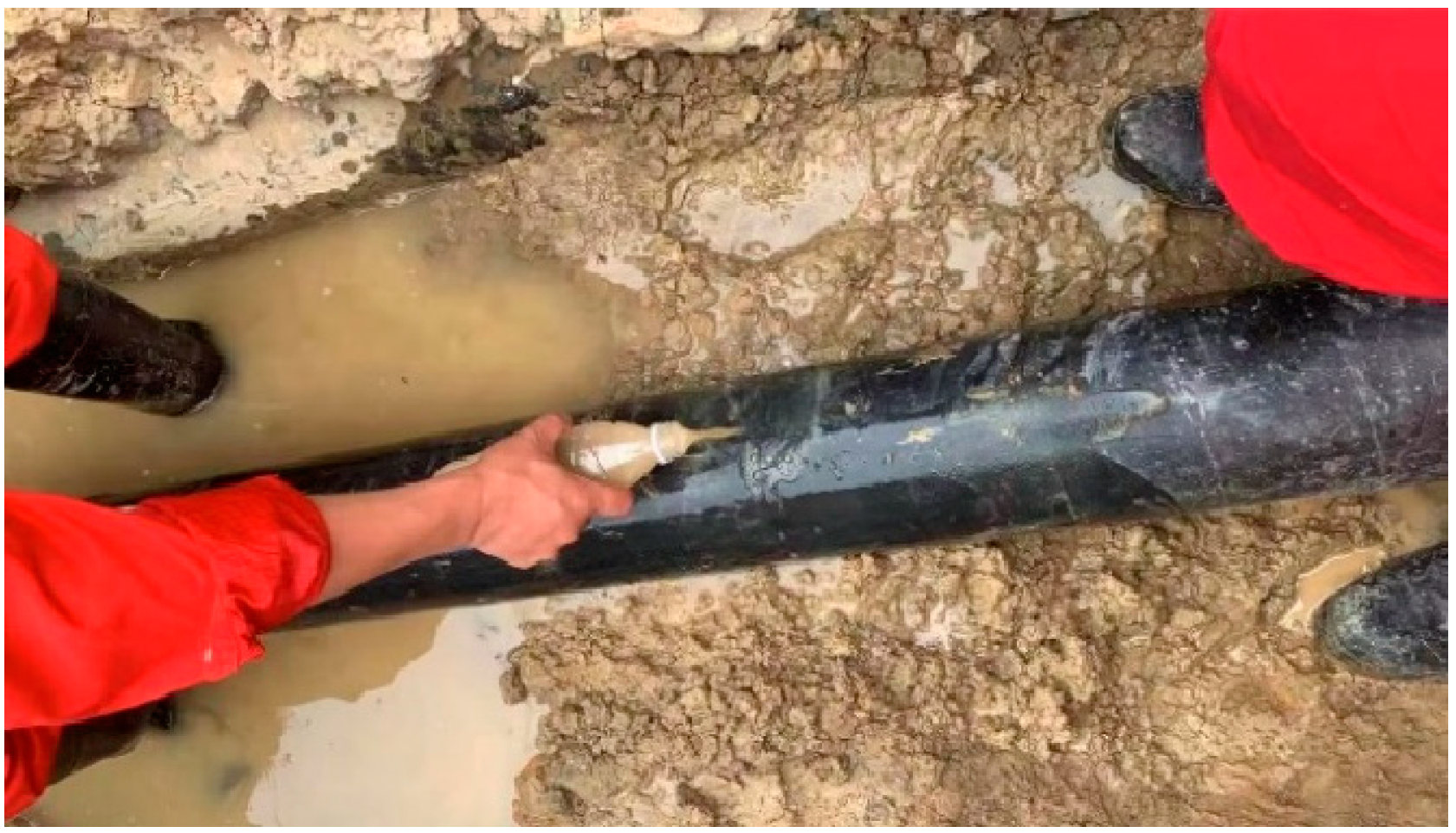

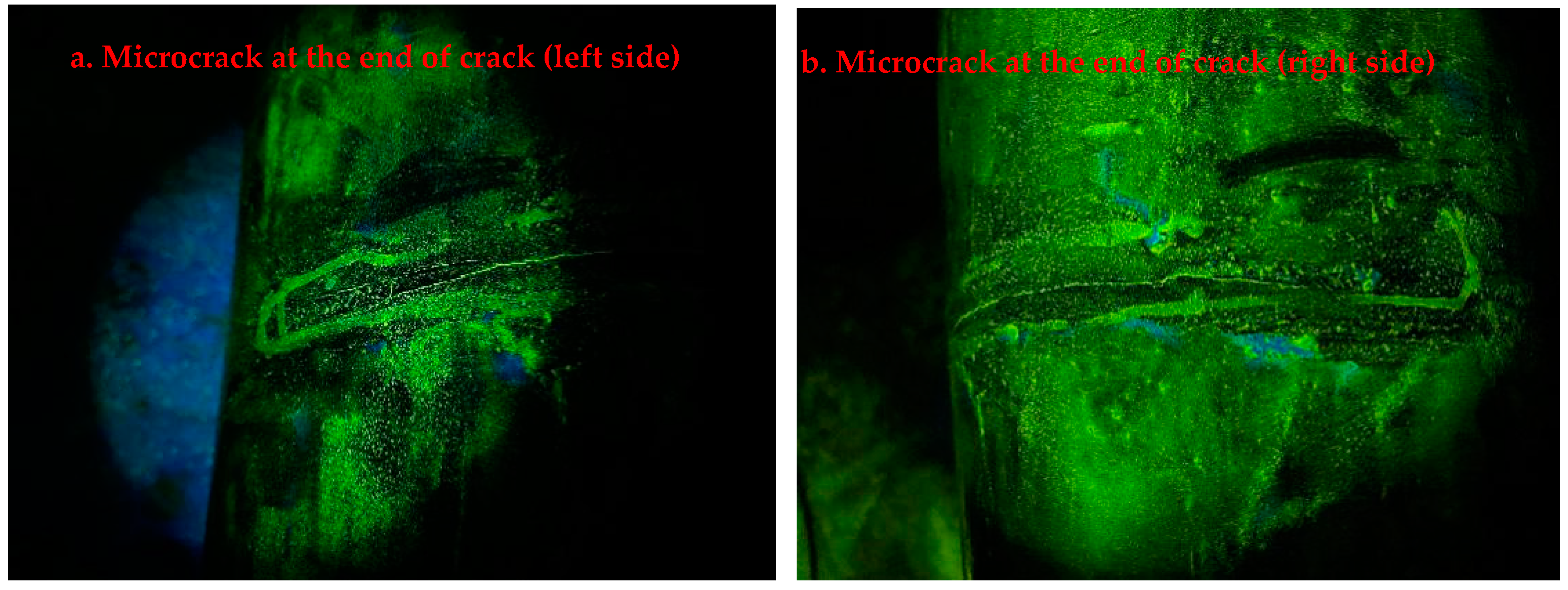

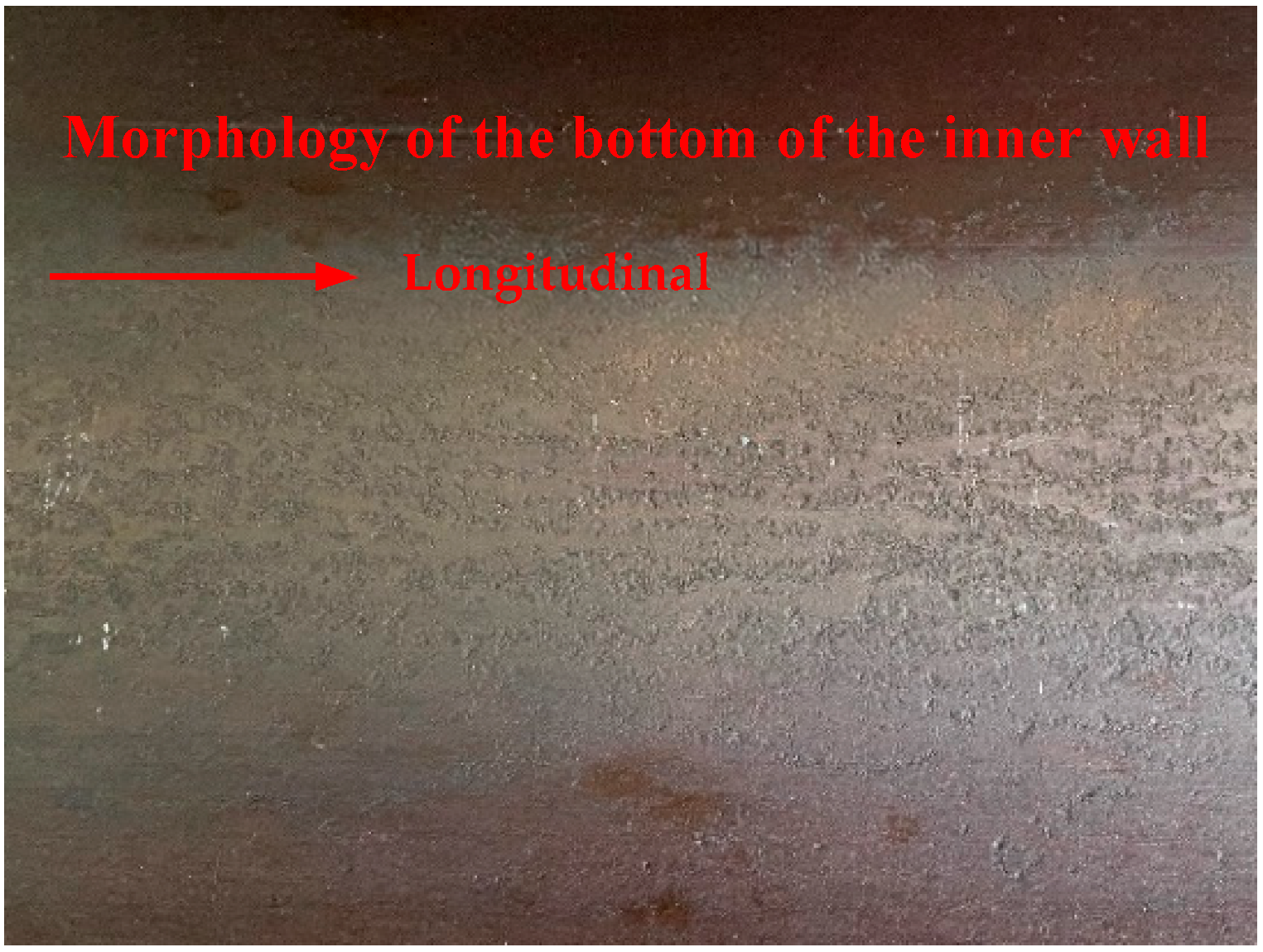


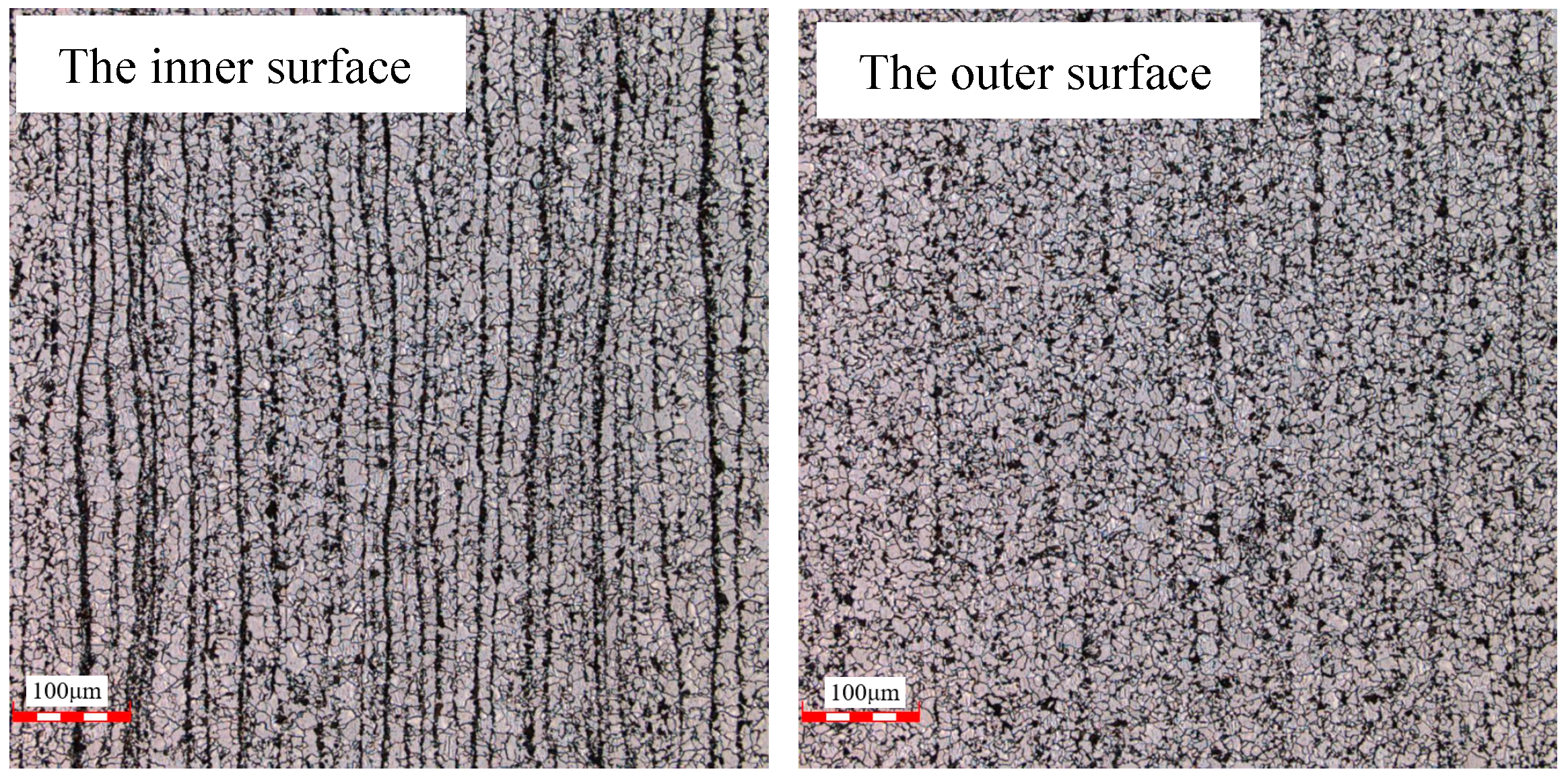

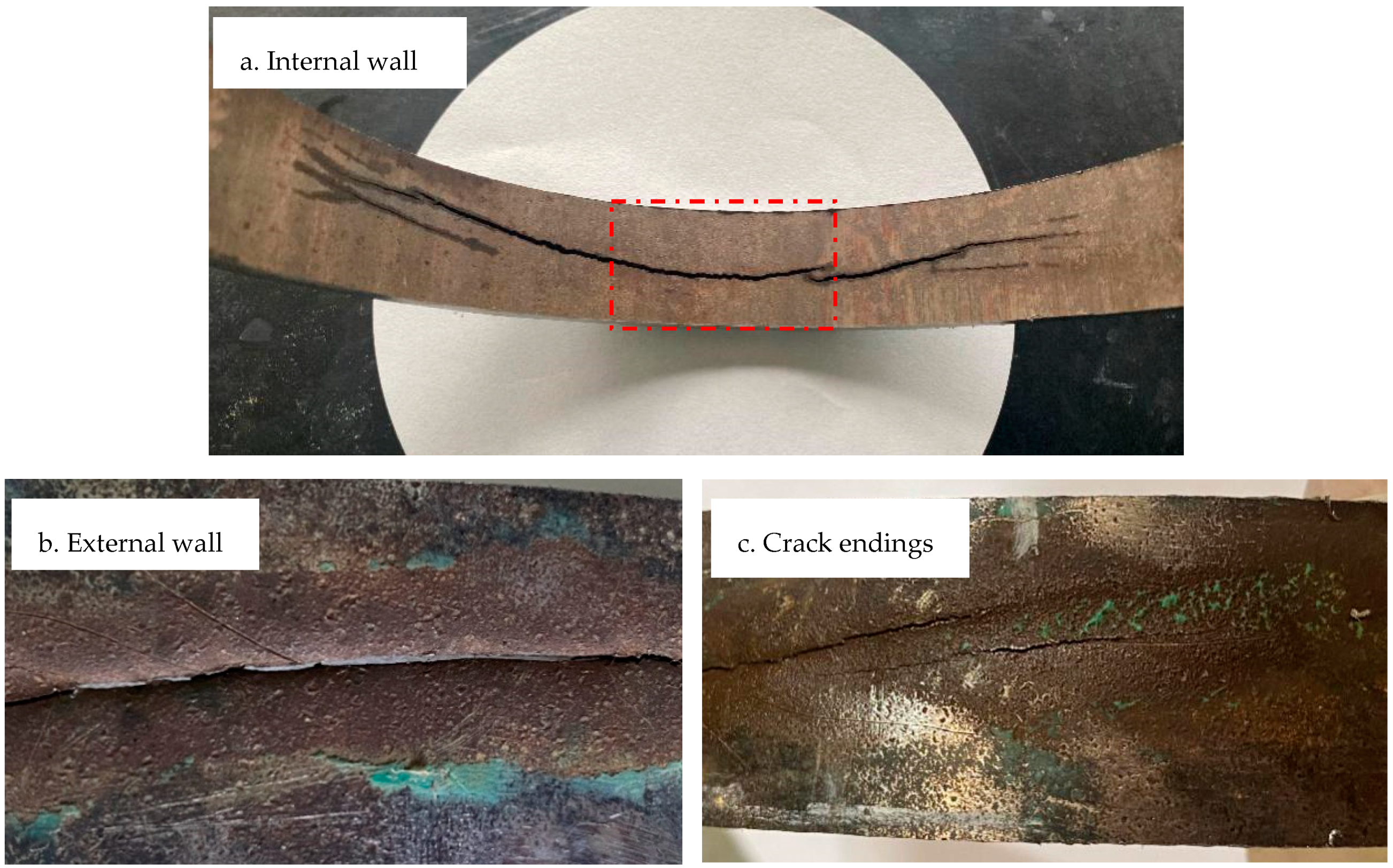
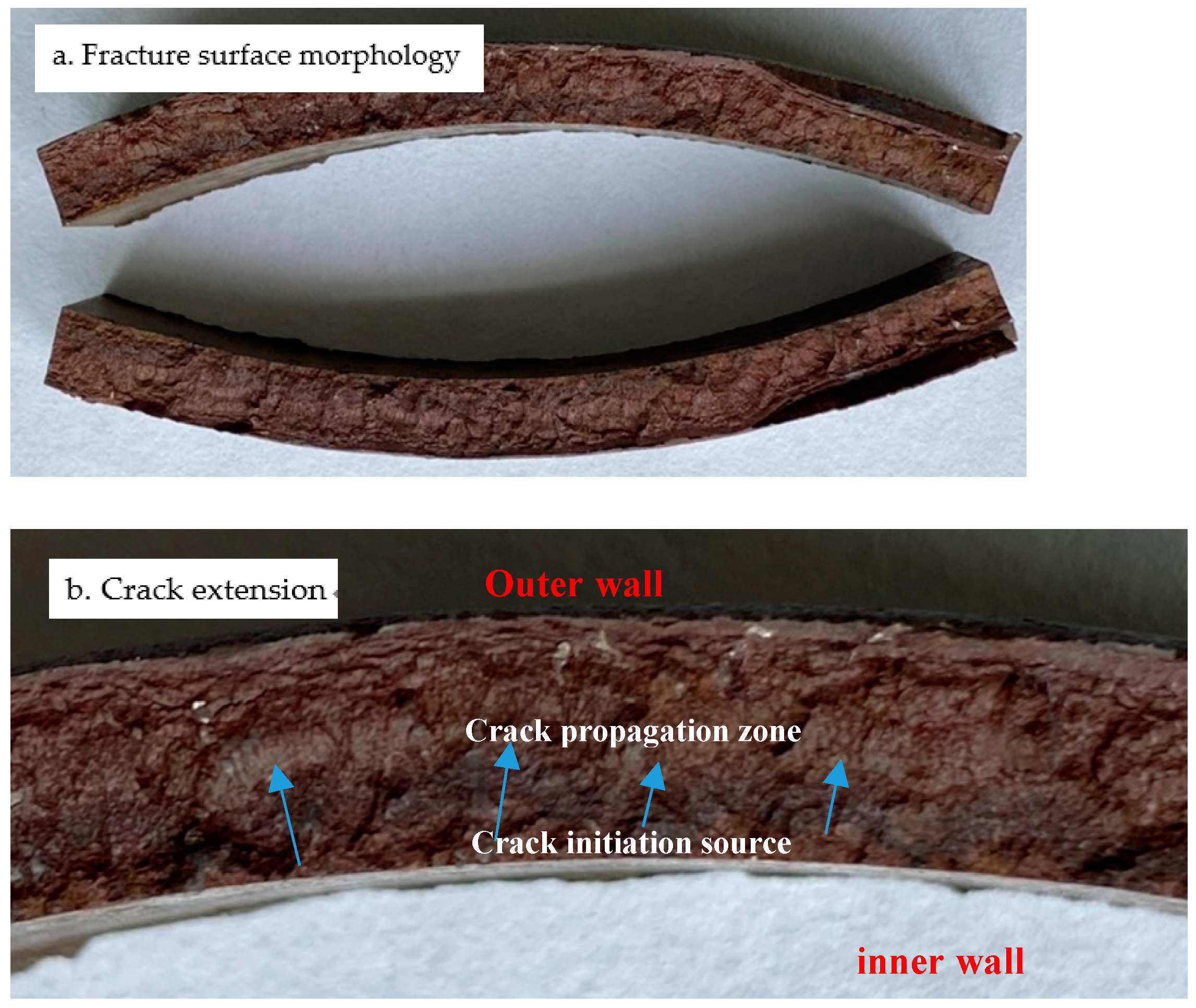


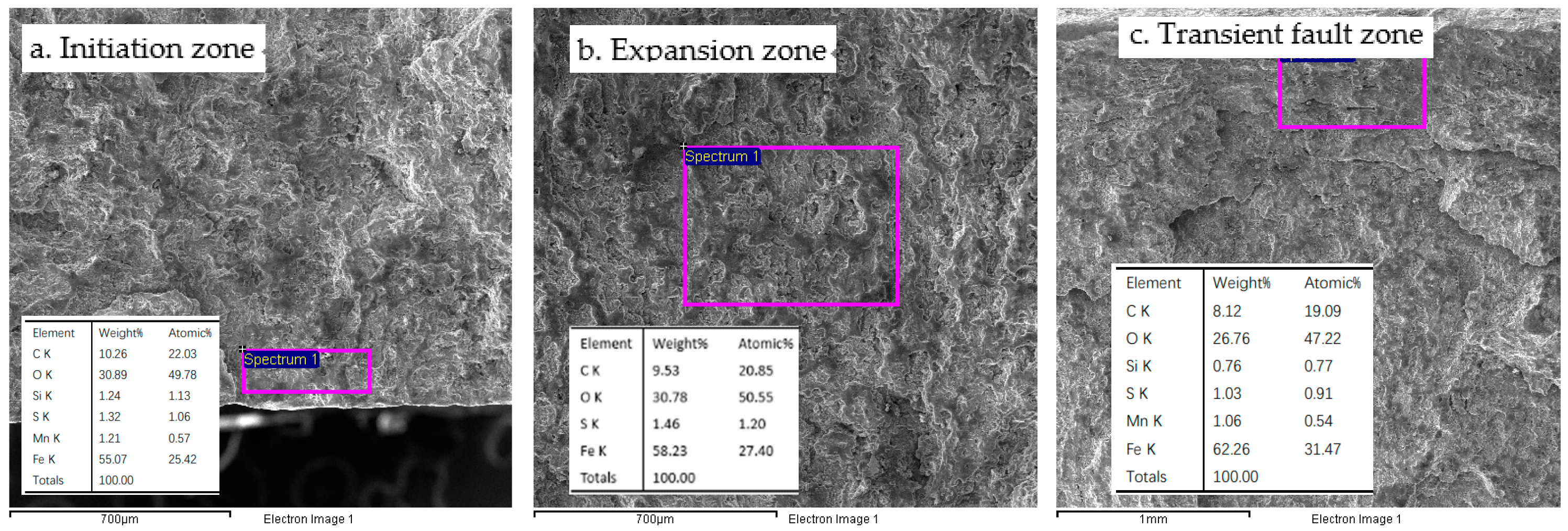


| Results | Tensile Strength Rm (MPa) | Yield Strength Rt 0.5 (MPa) | Elongation after Breaking A (%) | |
|---|---|---|---|---|
| Materials | ||||
| L360N | 538, 533, 519 | 404, 397, 391 | 40, 33, 22 | |
| API SPEC 5L [14] | 460–760 | 360–530 | ≥21.3 | |
| Element | C | Si | Mn | P | S | V | Ti | Nb | |
|---|---|---|---|---|---|---|---|---|---|
| 1# | L360N | 0.12 | 0.38 | 1.42 | 0.0126 | 0.005 | 0.0046 | 0.024 | 0.039 |
| 2# | L360N | 0.14 | 0.39 | 1.40 | 0.012 | 0.0054 | 0.0046 | 0.024 | 0.036 |
| API SPEC 5L [14] | ≤0.24 | ≤0.45 | ≤1.40 | ≤0.025 | ≤0.015 | ≤0.10 | ≤0.04 | ≤0.05 | |
| Results | Sample Size (mm) | Notch Shape | Test Temperature (°C) | Shock Absorption Energy (J) | |
|---|---|---|---|---|---|
| Materials | |||||
| L360N | 5 × 10 × 55 | V | 0 | 113, 118, 95 | |
| API SPEC 5L [14] | 5 × 10 × 55 | / | / | ≥13.5 | |
| Number | Non-Metallic Inclusion | Grain Size | Ribbon Structure | |||||||
|---|---|---|---|---|---|---|---|---|---|---|
| A | B | C | D | |||||||
| Thin | Thick | Thin | Thick | Thin | Thick | Thin | Thick | |||
| Top sample | 0.5 | 0 | 0.5 | 0 | 0 | 0 | 0.5 | 0 | 9.0 | 3.0 |
| Bottom sample | 0.5 | 0 | 0.5 | 0 | 0 | 0 | 0.5 | 0 | 9.5 | 3.0 |
Disclaimer/Publisher’s Note: The statements, opinions and data contained in all publications are solely those of the individual author(s) and contributor(s) and not of MDPI and/or the editor(s). MDPI and/or the editor(s) disclaim responsibility for any injury to people or property resulting from any ideas, methods, instructions or products referred to in the content. |
© 2024 by the authors. Licensee MDPI, Basel, Switzerland. This article is an open access article distributed under the terms and conditions of the Creative Commons Attribution (CC BY) license (https://creativecommons.org/licenses/by/4.0/).
Share and Cite
Zhao, X.; Zhang, Z.; He, Z.; Han, Y.; Yuan, J. Failure Causes Analysis of Circumferential Cracking on Gathering Pipeline in M Oil and Gas Field. Coatings 2024, 14, 770. https://doi.org/10.3390/coatings14060770
Zhao X, Zhang Z, He Z, Han Y, Yuan J. Failure Causes Analysis of Circumferential Cracking on Gathering Pipeline in M Oil and Gas Field. Coatings. 2024; 14(6):770. https://doi.org/10.3390/coatings14060770
Chicago/Turabian StyleZhao, Xuehui, Zicheng Zhang, Zhiwu He, Yan Han, and Juntao Yuan. 2024. "Failure Causes Analysis of Circumferential Cracking on Gathering Pipeline in M Oil and Gas Field" Coatings 14, no. 6: 770. https://doi.org/10.3390/coatings14060770





